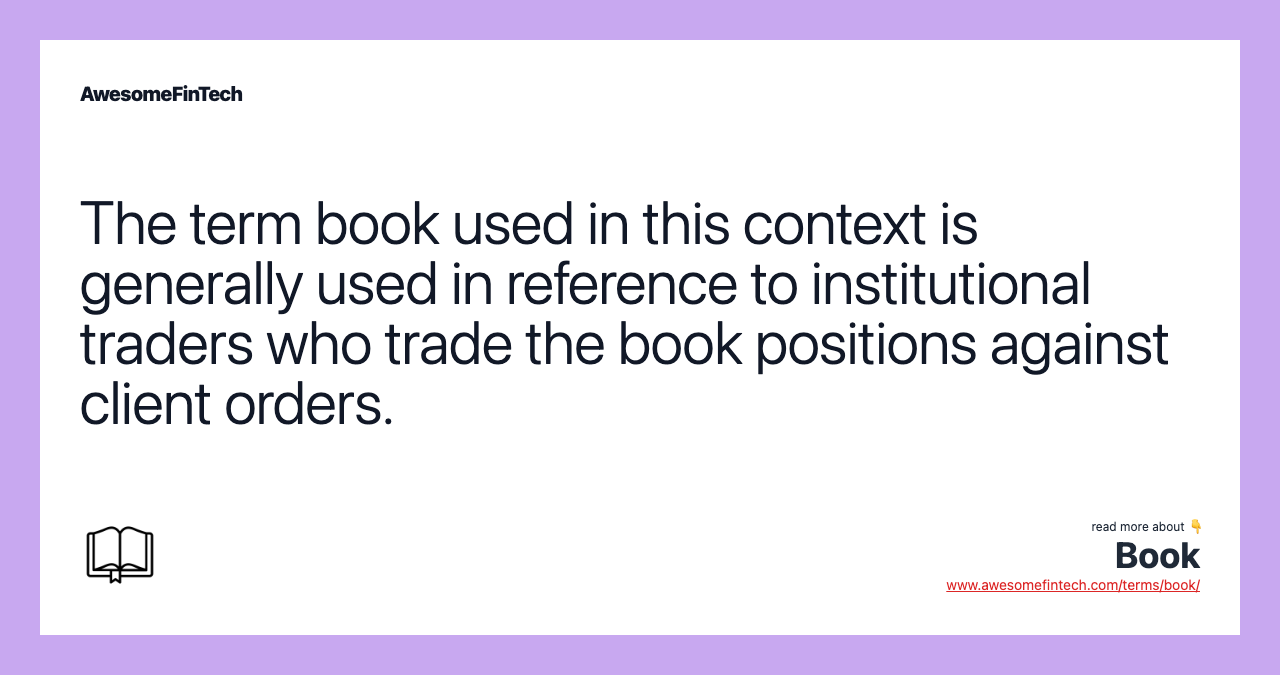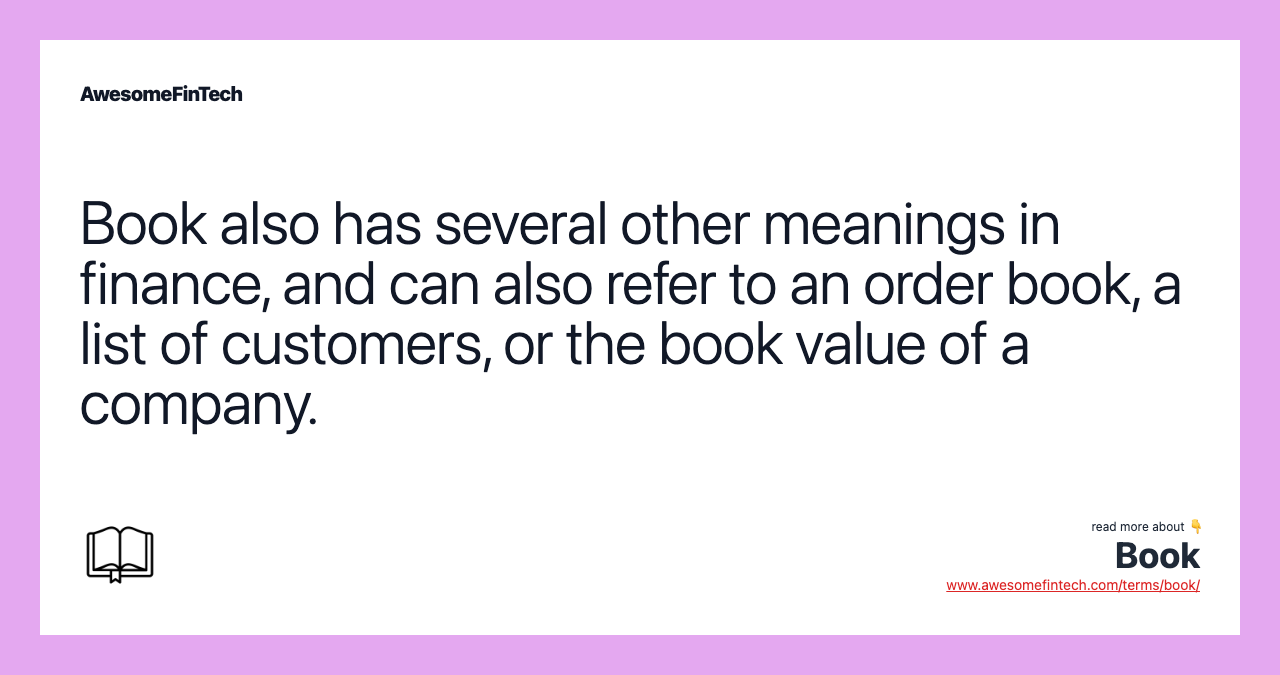Book
A book is a record of all the positions held by a trader. Yet some stock prices trade below book value, while others trade at many times book value, so it is a useful metric but is only one factor to consider when making a stock-related trading decision. A trader with a simple book may hold only two positions: say one long position of XYZ stock with 1,500 shares and a short position of 1,700 shares in ABC stock. The term book can refer to book value, which is an accounting term used to describe a key measurement of company value. The term book used in this context is generally used in reference to institutional traders who trade the book positions against client orders.

What Is a Book?
A book is a record of all the positions held by a trader. The book shows the total amount of long and short positions that the trader has undertaken. Institutional traders maintain a book to facilitate trades for their customers and to monitor for risk and opportunities. This may include trading the positions in the book with customers or attempting to capture the bid/ask spread.



Understanding the Trading Book
A trader with a simple book may hold only two positions: say one long position of XYZ stock with 1,500 shares and a short position of 1,700 shares in ABC stock. Keeping an up-to-date book allows a trader to be aware of his positions and the risk exposure related to those positions.
A trader will then monitor these positions and look for opportunities to trade their positions against client orders. This may provide the client with a better price than other bids/offers available, and will also allow the trader to offset some of their own position. They may also utilize their positions to capture the bid/ask spread. For example, if the trader can buy and the bid and a client is buying from them at the ask, they can capture the spread for a small profit.
Many traders make a market in a particular stock, bond, futures contract, currency pair, or options market, which means that they facilitate transactions for customers. Traders use their firm's capital to maintain a book of long and short positions and provide a bid and ask price to investors. The bid is the highest advertised price to buy a security, while the ask or offer is the lowest advertised to sell a security.
The positions within the book will fluctuate in value as the security prices rise and fall. This will impact the profitability of the trader and the firm they work for.
Retail traders may also refer to their own positions as a book, although the term is mostly associated with institutional traders or traders who have clients.
Other Ways the Term "Book" Is Used in Finance
The term book is used in many ways in a financial or business context.
The term book can refer to book value, which is an accounting term used to describe a key measurement of company value. Book value is related to the balance sheet formula of assets - liabilities = equity.
Book value per common share (BVPS) of stock is a ratio that measures the amount of equity the company maintains per share of common stock. In theory, if the company sold all of its assets and paid off all of its liabilities, the amount remaining would be equity. If there is more equity available per common share, then each share is theoretically more valuable to a stockholder. Yet some stock prices trade below book value, while others trade at many times book value, so it is a useful metric but is only one factor to consider when making a stock-related trading decision.
For traders, the order book represents the current depth and liquidity in a market by showing the bids and offers, along with their sizes, in a security. An order book may also refer to the list of a firm's customer orders that will be filled in future months. The dollar value of the order book is an indication of future sales and the growth prospects of the business. In the financial markets, an order book is all the buy and sell orders currently submitted in a security.
A book can also refer to the customer list maintained by a particular financial professional, salesperson, or small business owner. This book of business is often the key profit center for such individuals.
Example of a Position Book in the Stock Market
Assume a floor trader trades Apple Inc. (AAPL) stock. In this case, their book only consists of one stock, but the book must still accurately show how many shares long or short the trader has. For an active trader, this could change substantially throughout the day. The book will also typically show the dollar value of the position(s), as this will help the trader manage their risk and capital.
The trader may open the day with a long position of 10,000 shares. Depending on their view of whether the price will rise or fall overall they may favor buying or selling more. For example, if they are negative about the prospects of the day, if buy orders are hitting the offer, the floor trader may take the opportunity to sell 3,000 shares on the offer. Their book now shows a long position of 7,000 shares.
The price starts getting stronger, and the floor trader's view turns more bullish. As the price rises, they may look for opportunities to buy during short-term pullbacks or when the bid is getting hit more often. They buy 2,000 shares on the bid. Their book now shows 9,000 shares long.
As the price rises, they take the opportunity to sell 5,000 shares on the offer into strength, locking in a profit. Their book now shows 4,000 shares. This happens throughout the trading day, and for many institutional traders, their book will contain changing positions in multiple stocks or assets.
Related terms:
Best Ask
The best ask is the lowest quoted offer price from competing market makers for a particular trading instrument. read more
Best Bid
"Best bid" refers to the highest quoted bid for a particular security among all bids by competing market makers and participants. read more
Bid-Ask Spread
A bid-ask spread is the amount by which the ask price exceeds the bid price for an asset in the market. read more
Bond : Understanding What a Bond Is
A bond is a fixed income investment in which an investor loans money to an entity (corporate or governmental) that borrows the funds for a defined period of time at a fixed interest rate. read more
Book Value : Formula & Calculation
An asset's book value is equal to its carrying value on the balance sheet, and companies calculate it by netting the asset against its accumulated depreciation. read more
Bull
A bull is an investor who invests in a security expecting the price will rise. Discover what bullish investors look for in stocks and other assets. read more
Buy Limit Order
A buy limit order is an order to purchase an asset at or below a specified price. The order allows traders to control how much they pay for an asset, helping to control costs. read more
Book Value Per Share (BVPS)
Book value per share (BVPS) measures a company's book value on a per-share basis. read more
Commercial Trader
A commercial trader trades on behalf of a business or institution. In the commodities market, commercial traders are hedgers. read more
Common Stock
Common stock is a security that represents ownership in a corporation. read more